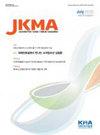Diagnosis and treatment of dysphagia
IF 0.5
Q3 MEDICINE, GENERAL & INTERNAL
引用次数: 0
Abstract
Background: Dysphagia refers to an abnormality in the process of transporting food from the mouth to the stomach. Patients with dysphagia have a high risk of airway aspiration, which can often lead to fatal complications such as pneumonia and asphyxia. Recently, interest in the clinical importance of dysphagia has increased in the medical community and society at large.Current Concepts: Dysphagia can be caused by neurological diseases such as stroke and brain injury, or by non-neurological diseases such as head and neck cancer or diverticulum. Diagnosis is mainly performed using videofluoroscopic swallowing study or endoscopic evaluation of swallowing based on a detailed history and physical examination, scintigraphy or esophageal manometry may also be helpful. Recently developed imaging technology using 3-dimensional computed tomography and dynamic magnetic resonance imaging has been implemented. Treatment of dysphagia can be divided into compensatory and facilitative rehabilitation techniques. The most important principle for successful treatment of dysphagia is that it should be performed with a multidisciplinary team approach.Discussion and Conclusion: Dysphagia is an important problem that can seriously impair the patients’ quality of life. Although the general public and medical professionals are interested in dysphagia, many unknown aspects exist regarding the mechanism of dysphagia, and few treatments have been sufficiently proven in terms of safety and effectiveness. Therefore, much attention and effort is still required.吞咽困难的诊断与治疗
背景:吞咽困难是指食物从口腔输送到胃的过程中出现异常。吞咽困难的患者呼吸道误吸的风险很高,这往往会导致致命的并发症,如肺炎和窒息。最近,对吞咽困难的临床重要性的兴趣在医学界和整个社会都有所增加。当前概念:吞咽困难可以由神经系统疾病引起,如中风和脑损伤,也可以由非神经系统疾病引起,如头颈癌或憩室。诊断主要是通过影像透视吞咽检查或基于详细病史和体格检查的内镜吞咽评估来进行的,闪烁成像或食管测压也可能有帮助。最近开发的成像技术使用三维计算机断层扫描和动态磁共振成像已经实现。吞咽困难的治疗可分为代偿和促进康复技术。成功治疗吞咽困难的最重要的原则是它应该在多学科团队的方法下进行。讨论与结论:吞咽困难是严重影响患者生活质量的重要问题。尽管公众和医学专业人士对吞咽困难感兴趣,但关于吞咽困难的机制存在许多未知的方面,并且很少有治疗方法在安全性和有效性方面得到充分证明。因此,仍然需要更多的关注和努力。
本文章由计算机程序翻译,如有差异,请以英文原文为准。
求助全文
约1分钟内获得全文
求助全文
来源期刊

Journal of The Korean Medical Association
Medicine-General Medicine
CiteScore
0.50
自引率
0.00%
发文量
84
审稿时长
4-8 weeks
期刊介绍:
The Journal of the Korean Medical Association (JKMA) is the official peer-reviewed, open-access, monthly journal of the Korean Medical Association (KMA). It contains articles in Korean or English. Its abbreviated title is ''J Korean Med Assoc''. The aims of the Journal include contributing to the treatment of and preventing diseases of public health importance and to improvement of health and quality of life through sharing the state-of the-art scientific information on medicine by the members of KMA and other national and international societies.
 求助内容:
求助内容: 应助结果提醒方式:
应助结果提醒方式:


